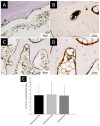3D Printed Scaffold Based on Type I Collagen/PLGA_TGF-β1 Nanoparticles Mimicking the Growth Factor Footprint of Human Bone Tissue
- PMID: 35267680
- PMCID: PMC8912467
- DOI: 10.3390/polym14050857
3D Printed Scaffold Based on Type I Collagen/PLGA_TGF-β1 Nanoparticles Mimicking the Growth Factor Footprint of Human Bone Tissue
Abstract
In bone regenerative strategies, the controlled release of growth factors is one of the main aspects for successful tissue regeneration. Recent trends in the drug delivery field increased the interest in the development of biodegradable systems able to protect and transport active agents. In the present study, we designed degradable poly(lactic-co-glycolic)acid (PLGA) nanocarriers suitable for the release of Transforming Growth Factor-beta 1 (TGF-β1), a key molecule in the management of bone cells behaviour. Spherical TGF-β1-containing PLGA (PLGA_TGF-β1) nanoparticles (ca.250 nm) exhibiting high encapsulation efficiency (ca.64%) were successfully synthesized. The TGF-β1 nanocarriers were subsequently combined with type I collagen for the fabrication of nanostructured 3D printed scaffolds able to mimic the TGF-β1 presence in the human bone extracellular matrix (ECM). The homogeneous hybrid formulation underwent a comprehensive rheological characterisation in view of 3D printing. The 3D printed collagen-based scaffolds (10 mm × 10 mm × 1 mm) successfully mimicked the TGF-β1 presence in human bone ECM as assessed by immunohistochemical TGF-β1 staining, covering ca.3.4% of the whole scaffold area. Moreover, the collagenous matrix was able to reduce the initial burst release observed in the first 24 h from about 38% for the PLGA_TGF-β1 alone to 14.5%, proving that the nanocarriers incorporation into collagen allows achieving sustained release kinetics.
Keywords: 3D printed scaffolds; TGF-β1; bone; drug delivery; polymeric nanoparticles; tissue regeneration; type I collagen.
Conflict of interest statement
The authors declare no conflict of interest.
Figures







Similar articles
-
Biodegradable chitosan scaffolds containing microspheres as carriers for controlled transforming growth factor-beta1 delivery for cartilage tissue engineering.Chin Med J (Engl). 2007 Feb 5;120(3):197-203. Chin Med J (Engl). 2007. PMID: 17355821
-
TGF-beta1 release from biodegradable polymer microparticles: its effects on marrow stromal osteoblast function.J Bone Joint Surg Am. 2001;83-A Suppl 1(Pt 2):S82-91. J Bone Joint Surg Am. 2001. PMID: 11314800
-
Fabrication of 3D Printed Poly(lactic acid)/Polycaprolactone Scaffolds Using TGF-β1 for Promoting Bone Regeneration.Polymers (Basel). 2021 Oct 28;13(21):3731. doi: 10.3390/polym13213731. Polymers (Basel). 2021. PMID: 34771286 Free PMC article.
-
Recent advances in PLGA-based biomaterials for bone tissue regeneration.Acta Biomater. 2021 Jun;127:56-79. doi: 10.1016/j.actbio.2021.03.067. Epub 2021 Apr 6. Acta Biomater. 2021. PMID: 33831569 Review.
-
Application of Scaffold-Based Drug Delivery in Oral Cancer Treatment: A Novel Approach.Pharmaceutics. 2024 Jun 14;16(6):802. doi: 10.3390/pharmaceutics16060802. Pharmaceutics. 2024. PMID: 38931923 Free PMC article. Review.
Cited by
-
Nanomaterial application for protein delivery in bone regeneration therapy.Braz J Med Biol Res. 2025 Feb 3;58:e14057. doi: 10.1590/1414-431X2024e14057. eCollection 2025. Braz J Med Biol Res. 2025. PMID: 39907403 Free PMC article. Review.
-
An Up-to-Date Review of Materials Science Advances in Bone Grafting for Oral and Maxillofacial Pathology.Materials (Basel). 2024 Sep 28;17(19):4782. doi: 10.3390/ma17194782. Materials (Basel). 2024. PMID: 39410353 Free PMC article. Review.
-
Advantages of nanoencapsulation in the delivery of therapeutics for bone regeneration.Nanomedicine (Lond). 2025 Apr;20(8):773-775. doi: 10.1080/17435889.2025.2462518. Epub 2025 Feb 5. Nanomedicine (Lond). 2025. PMID: 39907195 No abstract available.
-
Harnessing the Potential of PLGA Nanoparticles for Enhanced Bone Regeneration.Pharmaceutics. 2024 Feb 15;16(2):273. doi: 10.3390/pharmaceutics16020273. Pharmaceutics. 2024. PMID: 38399327 Free PMC article. Review.
-
3D-Printing for Critical Sized Bone Defects: Current Concepts and Future Directions.Bioengineering (Basel). 2022 Nov 11;9(11):680. doi: 10.3390/bioengineering9110680. Bioengineering (Basel). 2022. PMID: 36421080 Free PMC article. Review.
References
-
- Moreira C.A., Dempster D.W., Baron R., Feingold K.R., Anawalt B., Boyce A., Chrousos G., de Herder W.W., Dhatariya K., Dungan K., et al. Endotext [Internet] MDText.com, Inc.; South Dartmouth, MA, USA: 2000. Anatomy and ultrastructure of bone-histogenesis, growth and remodeling. - PubMed
-
- Bismar H., Kloppinger T., Kloppinger K., Schuster E.M., Balbach S., Diel I., Ziegler R., Pfeilschifter J. Transforming growth factor (TGF-) levels in the conditioned media of human bone cells: Relationship to donor age, bone volume, and concentration of TGF-in human bone matrix in vivo. Bone. 1999;24:565–569. doi: 10.1016/S8756-3282(99)00082-4. - DOI - PubMed
Grants and funding
LinkOut - more resources
Full Text Sources

